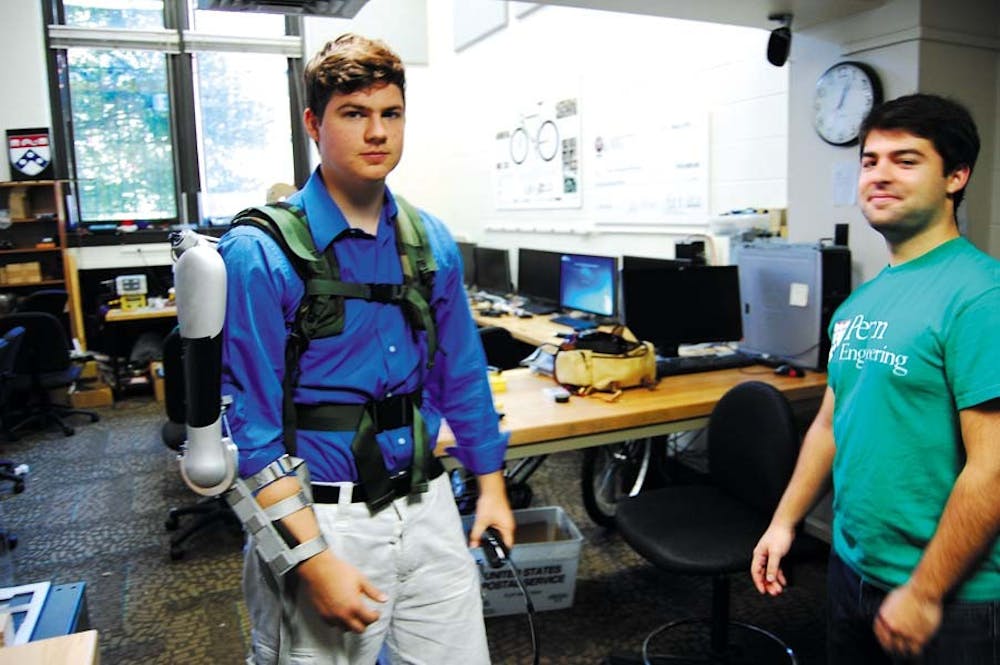
First year School of Engineering graduate student Nicholas McGill tests out the Titanic Arm he and his teammates, including first year Engineering graduate student Nick Parrotta, designed as part of their senior design project.
Credit: Jing RanThe Penn senior design team that just won an award for their Titan Arm is looking for a way forward with 3D printing.
The Titan Arm project, which features a powered upper body exoskeleton to augment strength and helps with rehabilitation, recently got first runner-up in the National Institutes of Health Design by Biomedical Undergraduate Teams Competition. It won second prize in the senior design competition last year.
Related: Senior Design Competition winners
Inspired by California company Ekso Bionics’ robot body suit that helps people paralyzed from the waist down, the team decided after in-depth market research to develop an upper body exoskeleton that is not connected to an external power source and is light weight and low cost.
“Current exoskeletons are prohibitorily costly — an Ekso Bionics suit requires $110,000 and a yearly service contract,” Nick Parrotta, a member of the team currently pursuing a master’s degree at Penn, said. “Being a senior design team, even though we did some fundraising, we were nowhere close to that budget. So it’s both an altruistic goal to create a low cost [arm] as well as a limitation of our situation.”
Other than getting money from the Mechanical Engineering Department, the team also reached out and did some fundraising to get organizational sponsors and grants by participating in some competitions.
“Early on we got into the Cornell Cup … and received additional funding from them as finalists,” first-year graduate student in robotics Nicholas McGill said. “That was a really important part in making it feasible.”
“Right now we are also looking at patents. Going forward, it’s always good to have a patent at your back,” he added. “Commercialization is an avenue that’s tough to go down — it involves humans, which means a lot of testing and regulations … we are not certain at this point.”
The team is exploring new directions both commercially and technologically, introducing more applications of 3D printing technology into the production.
“Currently this is a conventional manufacturing method — very time intensive,” Parrotta said. “If you want to make a different version of a different part, it takes a lot of effort and adds to both cost and complexity.” The plus of 3D printing, however, is that it “can customize components and make different versions with almost no change to the cost and complexity.”
The team also met with physical therapists in the Hospital of the University of Pennsylvania to incorporate the opinions of the therapists and patients to see what features and functionalities will improve their experience.
The team considered the biggest challenge during the development the mimicking of the shoulder’s range of motion.
“The shoulder is an extremely complicated joint. If you think about it you have this whole range of motion,” Parrotta said. “It’s a huge challenge, especially [because] we want to transfer a lot of the load-bearing capability through the shoulder to the suit.”
They went through a number of prototype designs and finally used a three-component joint that mimics what happens in a human shoulder joint.
Related: Engineers design robots in Pottruck pool
Though all four members on the team are mechanical engineers, their specializations in different aspects gave them a huge advantage.
Parrotta and Engineering graduate student Nikolay Vladimirov worked on all the machinery, cutting the metals and preparing the lead-up models. Team member Elizabeth Beattie, mechanical engineering doctoral candidate, worked for five years in an orthopedic lab and worked on the machine’s human interaction and how it transfers force. McGill, an electrical engineer, worked on the programming.
“We had a nice complement of skills, but we also share core competency so it was easier to talk to each other,” Parrotta said. “We split responsibilities and assigned them due to background.”
The Daily Pennsylvanian is an independent, student-run newspaper. Please consider making a donation to support the coverage that shapes the University. Your generosity ensures a future of strong journalism at Penn.
DonatePlease note All comments are eligible for publication in The Daily Pennsylvanian.





